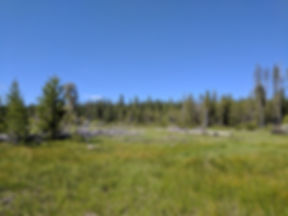
Fall River Resource Conservation District

Forest Stewardship
A major component of forest stewardship means preventing catastrophic wildfire by managing fuel loads. Removing dead, downed, diseased materials and thinning overcrowded forests will enhance wildlife habitat, preserve recreation, reduce tree mortality and prevent the harmful release of smoke from wildfire, which has been linked to degradation of human and environmental health. Decades of fire suppression has lead to unhealthy and unnatural forest conditions, increasing tree mortality, the impacts of drought and the rise of bark beetle. California's forests currently stand at a critical tipping point and require active forest management.

Unhealthy forests lack resiliency and diversity. Fires become catastrophic, destroying everything in their path. High burn severity diminishes soil productivity, increases erosion, and leaves areas susceptible to invasive species and future fires.

A healthy forest is both resilient and diverse. Resilient forests can recover from wildfire quickly, and foster more diversity. Forest diversity includes: plant diversity, wildlife diversity, and forest structure diversity. Larger, spaced out trees are also less susceptible to insect and disease spread.
What can we do?
-
Obtain value from sustainably harvested forest products to incentivise forest health projects.
-
Remove dead trees and thin overstocked small diameter trees that pose a risk to public safety.
-
Utilize controlled understory burning when possible.
Programs in Place:
Burney-Hat Creek Community Forest and Watershed Group
The purpose of this project is to improve social, environmental, and economic conditions in the Burney Creek and Hat Creek watersheds. These two watersheds include all of the land that drains into Burney Creek and Hat Creek, totaling 364,250 acres. Fifty-eight percent of this land is in the Lassen National Forest. Another 29 percent is owned by large private forestland owners and 4 percent by large ranches. The communities of Burney, Johnson Park, Hat Creek, Cassel, and Old Station lie within these two watersheds. Local communities suffer
from high unemployment and face high risk of wildfire in many surrounding forests. There is a recognized need for a coordinated public-private effort to address these and other concerns.
The goal of this project is to promote a healthy, productive forest ecosystem on both public and private lands. On a watershed scale, these lands will serve to create a fire resilient forest ecosystem with sustainable populations of wildlife and habitat, functioning watersheds, and recreational opportunities. The forest will help support quality of life and economic benefits in our local community.
Who we are:
The Burney Hat Creek Forest and Watershed Group is a community based collaborative of citizens, businesses, organizations, government and landowners who share a vision for a sustainable future for our communities and surrounding landscapes.
The Burney Hat Creek Forest and Watershed Group will:
-
Define a vision of sustainability that leads toward dollars and jobs that return to the community
-
Serve to educate the group and community members on forest health issues and sustainable ecosystem management.
-
Work systematically to organize and prioritize projects on the landscape.
-
Create a long-term demonstration of success by restoring livable rural communities within thriving ecosystems. The surrounding diverse ownerships will have healthy watersheds and abundant wildlife habitat.

FAQ
Does reducing fuel in our forests destroy wildlife habitat?
For many decades our forests have been deprived of fire due to suppression. Years of drought have left our forests susceptible to disease and insect infestation. Tree mortality has reached an all time high. Without active forest management, catastrophic wildfire and the compounded impacts of drought and bark-beetle infestation will dramatically alter the forests as we know them, completely changing or devastating wildlife habitats. To preserve diverse wildlife habitat we must promote healthy, resilient forests.
How will prescribed burns and burn piles play a role?
Prescribed burns in the forest will most likely be the lowest cost and most natural way to maintain the forest, especially once the excess fuel has been removed. The problem with prescribed burns is that there are few windows each year when the conditions are right to do these burns safely. While burn piles and prescribed burns will likely always be part of rural life, the smoke from those burns causes health problems and the air quality impacts need to be taken into account. The RCD is also supporting the bioenergy cluster project, which will allow for the utilization of biomass for energy production.
How does increased tree mortality affect forest management?
Tree mortality is at an all time high in California. Mortality of large conifers leaves the forest susceptible to catastrophic fires. Not all large dead trees will be removed as they provide important wildlife habitat, but many will have to be removed to protect public resources and safely. The removal of diseased/infested trees will slow the spread of disease and increase the available resources for healthy trees left on the landscape.
